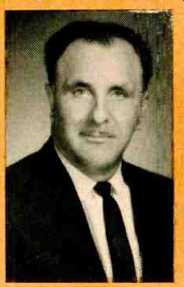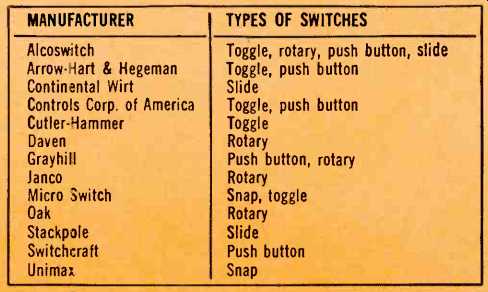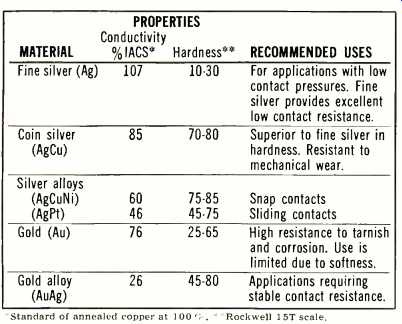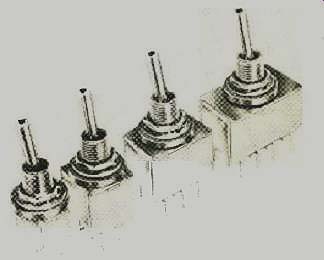
By A.F. CONTARINO [President, Alcoswtch (Div. Alco Electronic Products, Inc.)]
---The author, president of Alcoswitch, is active in the design and engineering of new switch products for his company. He was formerly on electrical engineer at the Naval Research laboratory.
Occupying far less space than their standard-sized counterparts, a wide variety of these tiny switches with full-sized ratings is now available in toggle, rotary, and pushbutton configurations.
With the coming of the Space Age, factors such as weight, size, reliability, stability, and adverse operating conditions have placed an endless constraints on equipment design. As is the case with the components used in all compact equipment, design engineers have had to fit switches into exceedingly small spaces. As a result, many types of miniature switches have been created--reduced to minimum size and weight--which bear little physical resemblance to the standard switches of the 1940's and, possibly, the 1930's. These miniature switches are currently available from a number of Manufacturers for laboratory, prototype, and production applications.
Miniature Toggle Switch
A miniature switch is a "reduced" version of its traditional full-size counterpart and usually performs the same functions (Table 1). Many of these new, tiny types are for applications involving printed-circuit pins rather than the standard solder-type lugs, which makes them ideal for dip soldering and PC use.
Manufacturers listed in Table produce similar types of box-style miniature toggle switches, with the exception of Controls Corp. of America, which produces a line of cylindrical toggle switches. Most of these manufacturers offer miniature types which meet critical environmental requirements, making them suitable for applications in the electrical equipment and electronic fields.
Most switch users are not aware of the fact that many of the miniature toggle switches handle unusually high currents despite their small size. In many cases, these ratings are higher than those of conventional size switches.
Their high current capabilities can be attributed to the frequently closer tolerances and better grades of materials used in the design and manufacture of these switches as compared to less-expensive, full-sized switches. Most of the manufacturers of miniature switches make use of solid coin silver contact, and movable contact bars, stainless-steel bushings and hardware, and a superior grade of plastic materials in insulation and case construction to withstand high heat, high impact, and to insure low dielectric losses.
By making use of silver, gold, and other exotic materials as alloys or platings, these switches are able to handle exceptionally high currents for a smaller contact area, resulting in a much lower operating-contact resistance (Table 3). By making use of inside and outside high-voltage barriers, many of the new miniature switches are capable of withstanding a much higher breakdown voltage in spite of the smaller case size.
Conventional toggle switches are usually rated at 3 A at 117 V a.c., whereas it is very common to find a typical 5A at 117-V a.c. rating in many miniatures.
The average life of the miniature toggle switch is 100,000 cycles and this is not unusual. In most cases, the life of these devices is longer than the life of the equipment into which they are built.

Table 1. The physical qualifications of miniature switches.

Table 2. Listing of major producers of miniature switches.

Table 3. Comparison of materials employed for contacts.

A miniature toggle switch is shown here in the center compared
with its standard-size counterpart. Rubber boot is at the right.

Miniature toggles are available up to 4-pole, double-throw.
Types Available
Besides making a line of commercial miniature switches, some companies also produce waterproof miniatures for the military, for marine use, and for hazardous applications, thereby meeting MIL-3950 specifications.
Industry has standardized the miniature bushing size at 1/4-40. A wide variety of decorative mounting hardware is available, including an unusual type of knurled nut which forms a perfect fit mounting. As a comparison, if a fixed area is available on a front panel, it is possible to have four tunes as many miniature toggle switches as the standard types.
These miniature switches are currently available in many styles of one-, two-, three-, and four-poles; in maintained; center-off; and momentary configurations just like standard switches. In addition, a miniature d.p.d.t. toggle with three active positions is available and can be used as a s.p. 3-position toggle switch. Prior to its introduction, the "three active position" function could be obtained only with a rotary switch.
Some companies imprint their miniature switches with the company name, part number, indications showing "on" positions, as well as current and voltage ratings.
It is quite a feat to have this information presented in such small space--but it meets the requirements of government and industry.
To meet the ever-growing need for multiple-pole toggle switches, many manufacturers have devised means of ganging three or four snap switches to form a rather compact multi-pole switch. Now miniature switch engineers have created a much smaller version with up to four poles encased in a single body. Case size is a mere 1 /2" x 1 ". The miniature switch industry has designed an unusual family of switches for engineers who prefer the "feel" of a standard 13/32" toggle but because of rear panel space limitations must use a miniature. In each case, these switches maintain the sane high current rating as their standard-size counterparts.
Recently, Cutler-Hammer and Alcoswitch introduced new accident-proof "lever-lock" miniature toggle switches for use in hazardous switching operations, particularly on machinery controls and aircraft instrument panels. These lever-lock switches are currently available in a variety of single- and double-pole, maintained, or center-off configurations.
Innovations to be found in miniature toggle switches are numerous. They are designed with a variety of terminals, including lugs, turrets, and pin types that are ideal for printed-circuit applications. Arrow-Hart & Hagerman produces a right-angle toggle switch expressly for printed-circuit use.
Color is helpful to the operators of miniature switches.
Plastic color caps (red, blue, black, white, and fluorescent tints) are available from most miniature switch makers.
A new trend, started by the miniature switch industry, is the use of these colored and fluorescent caps for easier and faster identification of operational devices in test equipment and computers. This color identification scheme has now been adopted for larger switches.
Miniature Rotaries
The biggest conversion from standard to miniature in the industry has probably occurred in the rotary switch field. One of the originators is Daren who for many years has produced a complete line of 1/2" diameter. MIL-grade rotary switches.
Not only have rotaries been reduced in size, but Oak has recently engineered a group of extremely small rotary switches measuring only 0.093" in diameter. These switches are designed expressly for direct welding to integrated circuit chips as well as for encapsulated circuits. Alcoswitch produces a 1/2" miniature rotary--with a built-in adjustable stop feature thereby allowing the user to alter stop positions to meet his requirements.
Because of the compact construction found in rotary miniatures, it is difficult to include a great number of poles with adequate contact area. For this reason, miniature rotaries are usually found to have lower current and lower voltage breakdown ratings as compared to the standard-sized rotary switches.
Potential life expectancy varies greatly in rotary switches--from 10,000 to an extreme of 100,000 operations. Many of these rotaries are sealed, visually in a single gang, and some, such as the Janco rotary switch, meet military specifications. However, there are many fine-grade miniature rotary switches currently being made with several gangs.
Daren provides its miniature rotaries as a "switch-in-knob" mounting where space behind the panel is at a premium. In this sort of mounting, the rotary switch requires only 3/16" behind the panel for terminals.
Miniature Push-Button Switches
There are two basic types of miniature pushbutton switches: snap-action and silent-action.
Grayhill probably has the most extensive line of miniature pushbutton switches, ranging in size from 1 /2" down to 1/4" in diameter.
The snap-action type usually requires a fair actuating force, on the order of 16 ounces to as much as 60 ounces.
In comparison, only 3 to 16 ounces are required for various types of silent-action switches. A current rating of 5 to 10 A at 117 volts a.c. is considered common in snap-action switches. Silent-action types have a maximum current capability of about 1 amp at 117 V a.c.

(left) Examples of miniature, pushbutton waterproof switches. (right)
The
smallest of these miniature rotary switches, shown next to the match head, is
6position type measuring 0.093" dia.
Push-button switches are produced as either normally open or normally closed. Some manufacturers are producing 1- and '2-pole double-throw versions and there is a 4-pole double-throw push-button switch on the market which will carry 6 A at 117 V a.c., using a 1/2" X 1" case.
With the increase in computer manufacturing, the illuminated push-button switch has been created to meet the growing need for visual switching.
The tiny T-1 series bulbs with long life expectancy are now in plentiful supply and have allowed the miniature push-button switch to be installed in complicated panels.
The large variety of illuminated push-button switches makes these the fastest growing segment of the switch industry. These miniature push buttons are available in both single and ganged versions. Only the size of the human finger limits the miniaturization possibilities of the miniature pushbutton switch.
(source: Electronics World, Oct. 1967)
Also see: Enclosed Rotary Switches